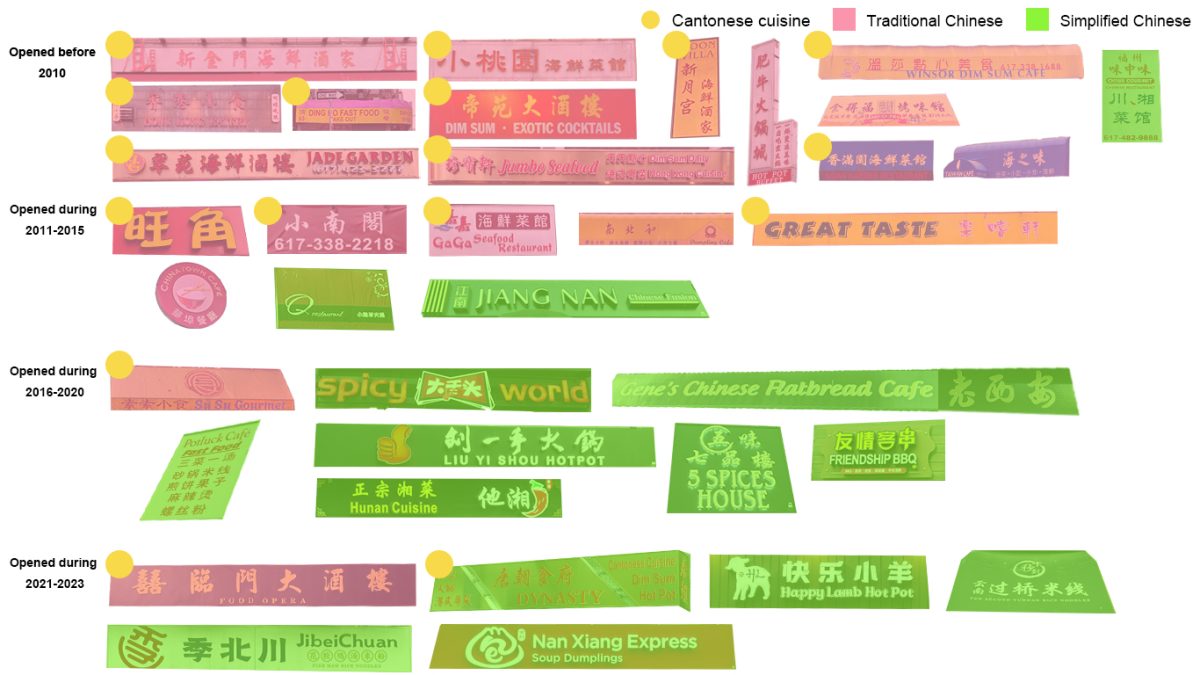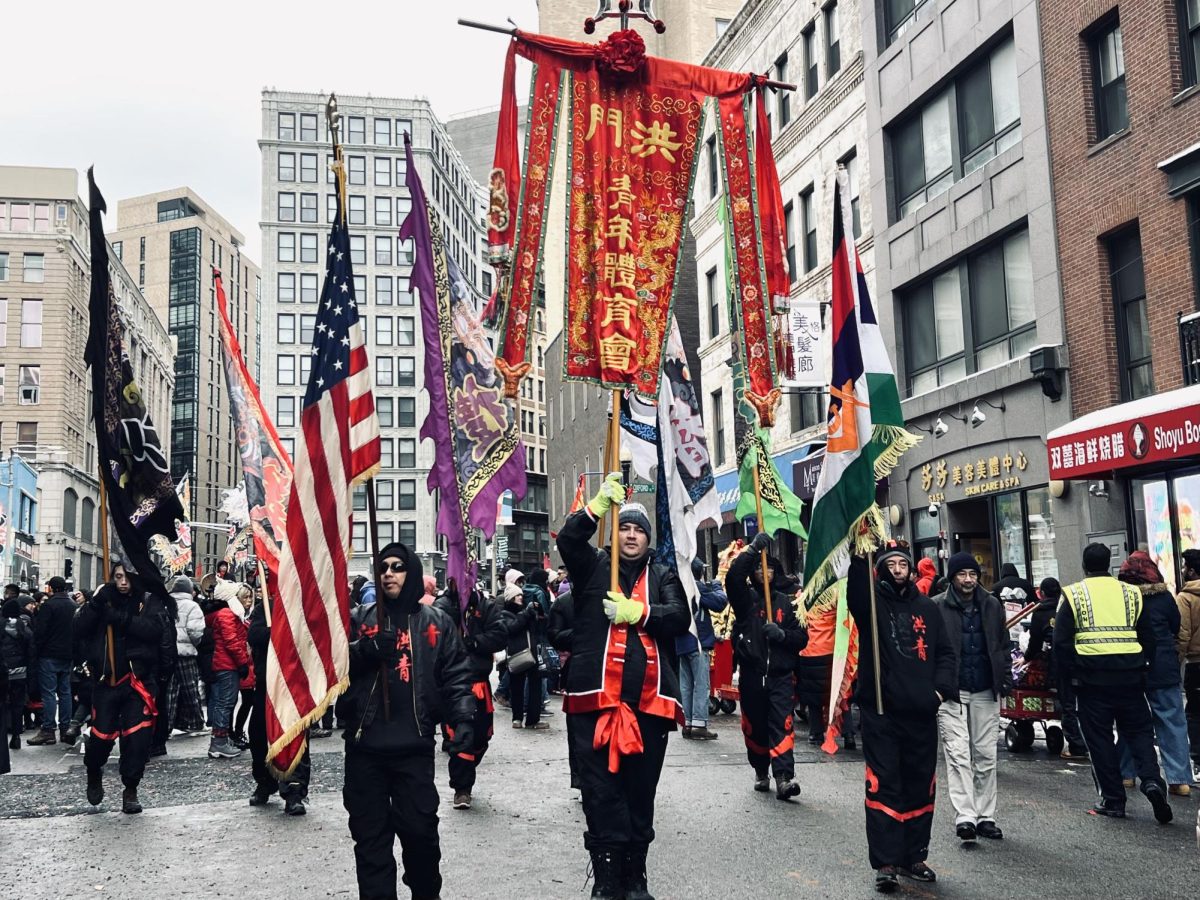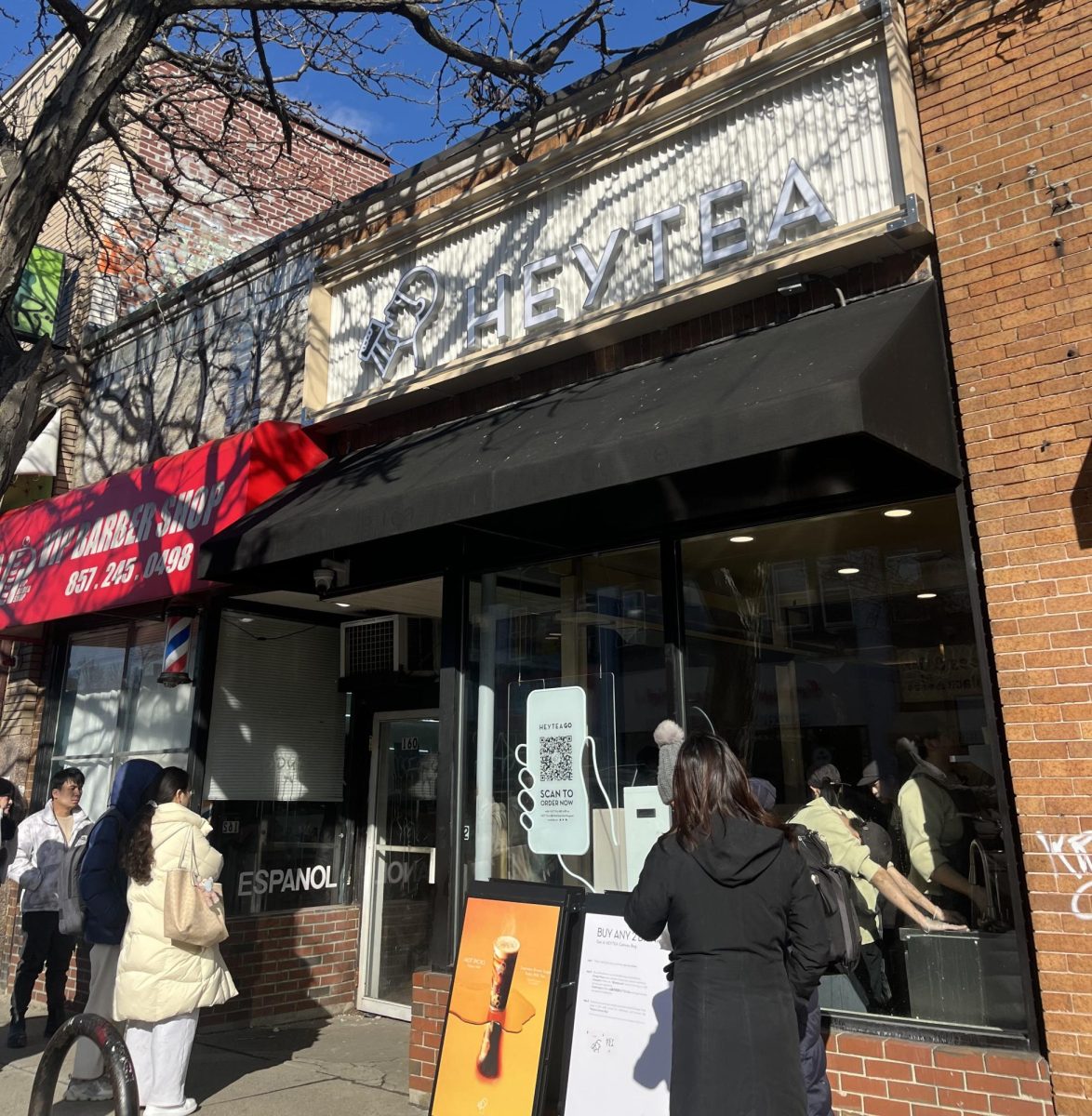Do you feel like you’ve seen a lot of similar Chinese restaurant signage – yellow background, red letters, and big Chinese names?
In the first few years of the 20th century, Boston’s Chinatown took shape as more restaurants and stores opened. Today, more than 100 years later, Chinatown is a business district, a residential neighbourhood, and a record of Boston’s Chinese immigrant history. Generations of immigrants have left different marks on the area.
Why do Chinese restaurants always look so “Chinese?” The first step is to understand what Chinese restaurant signs look like.

Opened before 2010: Currently, 36 Chinese restaurants exist in and around Boston’s Chinatown. This excludes Asian fusion cuisine, Japanese and Korean restaurants, milk tea stores, bakeries, and other stores. 14 of them opened before 2010. They almost look like the most standard stereotype of a Chinese restaurant, with bright and colourful signs.
Opened during 2011-2015: Among the restaurants that opened between 2011 and 2015, Jiangnan was the first one that used black as the background colour in its sign, and also the first restaurant to provide Jiangsu and Zhejiang cuisine in the sample.
Opened during 2016-2020: Five years later, the number of restaurants using a black background increased significantly. Out of all the restaurants that opened during this period three were Sichuan and Hunan.
Opened during 2021-2023: Of the six restaurants that have opened in the last three years, four were chain restaurants, a number that was zero for restaurants that opened before 2010.
After scrolling through the 36 restaurant signs, which colour stands out to you the most? Once the percentage of colours on the signs by code were identified, the data showed that the percentage of red, yellow, and black stood out.
Red
Imagine combining all the signs on one large canvas. In this canvas, the percentage of red pixels is 21.93%. The colour red is eye-catching and bright, and most importantly, it represents good luck in traditional culture. In Chinese, there is a common word for prosperity– “hong huo,” which is directly translated as “red” and “fire.” In addition to good luck, the colour red is also linked to spiciness.



Yellow
Yellow is also an eye-catching and bright colour. In ancient times, yellow was reserved for Chinese royal families. Additionally, yellow can represent the colour of gold in Chinese culture, suggesting wealth.


Black
Black, as a neutral colour, is a common colour in signs, and is no exception in Chinese restaurant signs. It usually appears as the background colour.


In addition to the colours, the names of the Chinese restaurants show an interesting pattern. Within the sample size, over 36% of the Chinese restaurants have English names that are unrelated to their Chinese names, and 20% are not accurately translated.

Overall, only about 27% (10 restaurants) located in Chinatown chose phonetic translations. This is not common compared to Japanese and Korean restaurants in Boston – their common practice has been to use only English names or choose direct phonetic translations.


Why do so many Chinese restaurants have English names that are completely or almost unrelated to their Chinese names? One possible answer is that many Chinese sign names are very difficult to translate into English.
Take Hunan Gourmet for example, the English name of this restaurant is two words and the Chinese name is four characters. However, these four characters in Chinese are related to an idiom, which means that these four express the meaning of much more than four characters. Even when translated as closely as possible, the original meaning of the Chinese name needs to be expressed in a single sentence.

Another possible reason is that even though the restaurant is operating in the United States, the owner still prioritizes the Chinese name. In Arlington, there is a Chinese restaurant called Szechuan’s Dumpling, whose Chinese name translates directly into English as “Enchanting Hangzhou” or “Druken in Hangzhou.”
Szechuan and Hangzhou are both place names in China, and the straight-line distance between the two is more than 960 miles. For reference, the distance from Boston to Atlanta, Georgia is about 900 miles. And the cuisines of Szechuan and Hangzhou are quite different, with Szechuan cuisine being spicy and Hangzhou cuisine being sweet.
The owner of Szechuan’s Dumpling shared that the restaurant used to be called Szechuan’s Dumpling, where they actually sold Szechuan cuisine. Because “foreigners” (the non-Chinese residents) in the neighbourhood already recognised the name as a Chinese restaurant, the owner decided not to change it. He thinks it is fine as long as Chinese customers can tell the cuisine from the Chinese name.


Signs and Immigration: Changes in Chinatown
Red and yellow colour take first and second place respectively in terms of colour percentage, and incomprehensible Chinese characters. It is interesting to note that Chinese restaurant signs are still changing.
Guangdong is a famous hometown of overseas Chinese. By the end of 2022, there were approximately over 30 million overseas Chinese originating from Guangdong Province, accounting for more than half of the total number of overseas Chinese worldwide. They are distributed across more than 160 countries and regions, with the United States being one of the major destinations. Due to a significant number of immigrants from Guangdong and Hong Kong, Cantonese cuisine and Hong Kong-style Cantonese cuisine have become indispensable components of overseas Chinese restaurants.

By the end of 2022, there were over 30 million overseas Chinese from Guangdong, counting as half of the total overseas Chinese population. Due to a significant number of immigrants from Guangdong and Hong Kong, Cantonese cuisine and Hong Kong-style Cantonese cuisine have become indispensable components of overseas Chinese restaurants.
A member from Chinatown Main Street shared the history she knew of the area. At the turn of the last century, Boston’s Chinese came mainly from Taishan City in Guangdong, and they were naturally an important part of Boston’s Chinatown. In the 1950s and 1960s, a significant number of people arrived from Hong Kong. Since the 1990s, more and more people from Fuzhou City, Fujian moved to the city. In recent years, most of the newcomers have come from northern provinces.

Since the introduction of simplified Chinese characters in mainland China in the 1950s, residents have gradually stopped using traditional characters. In Hong Kong, Macau, and Taiwan, however, traditional characters are still used today. When the new generation of immigrants joins Chinatown, there is a high probability that the new restaurants that open will no longer use traditional characters in signs.

The only restaurant in the 2023 group that uses traditional Chinese characters is “Hei La Moon” which was opened in Chinatown about two decades ago and relocated to a new address in 2022 due to urban planning. In recent years, even newly-opened Cantonese restaurants no longer use traditional Chinese characters in their signs.


Of the 36 Chinese restaurants in Boston’s Chinatown, 17 are Cantonese or Hong Kong-style Cantonese restaurants, 14 of which opened before 2015. Additionally, in Allston, a new restaurant district that has grown in recent years, only one of the more than 15 Chinese restaurants is a Cantonese restaurant.
The new generation of restaurants has also brought an interesting change in the pattern of sign colours.

Comparing the colour percentages of the signs from the four periods, it can be noted that the percentage of black has increased dramatically. This is closely linked to the emergence of a new generation of restaurants.
Chi Hing Law, an international student from Guangdong, explains, “Our local business people are very particular about good luck, and red stands for prosperity. The phone number, the opening date, and everything else should be linked to good luck.”
Shuyu Liu, an international student living in Hong Kong, added, “A black background with white characters would look like a funeral-related business in Hong Kong, Guangdong.”
Even though the colour black is not an auspicious colour in Chinese culture, many of the young restaurant owners in Boston prefer it to give a more transformed and modern look to their business. That’s not to say that these young owners don’t care about good luck, it’s just that they don’t usually associate sign colours strongly with luck anymore.
Boston’s Chinatown dates back to the mid-1870s when most white Bostonians refused to visit Chinese restaurants because of discrimination, racism, and language and cultural barriers. As time changed, Chinese restaurants became more and more popular. Many Chinese restaurants can already be seen in the 1926 map produced by Global Boston. Boston’s Chinatown is clearly an important and growing part of the city’s business district.


From exoticization to Cantonese style, to today’s creation of signs by a new generation of immigrants, Chinatown restaurant signs are a microcosm of Chinese immigrant history.
What will Boston’s Chinatown look like in the future?







